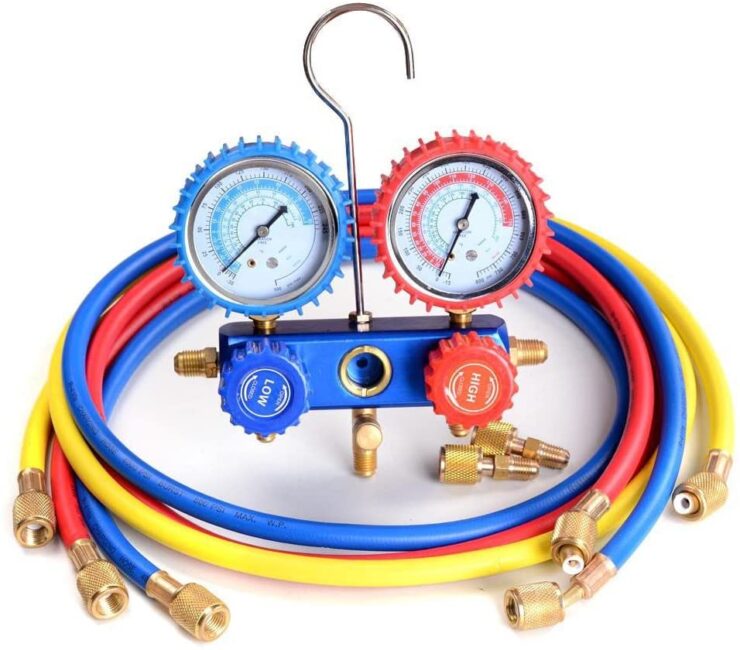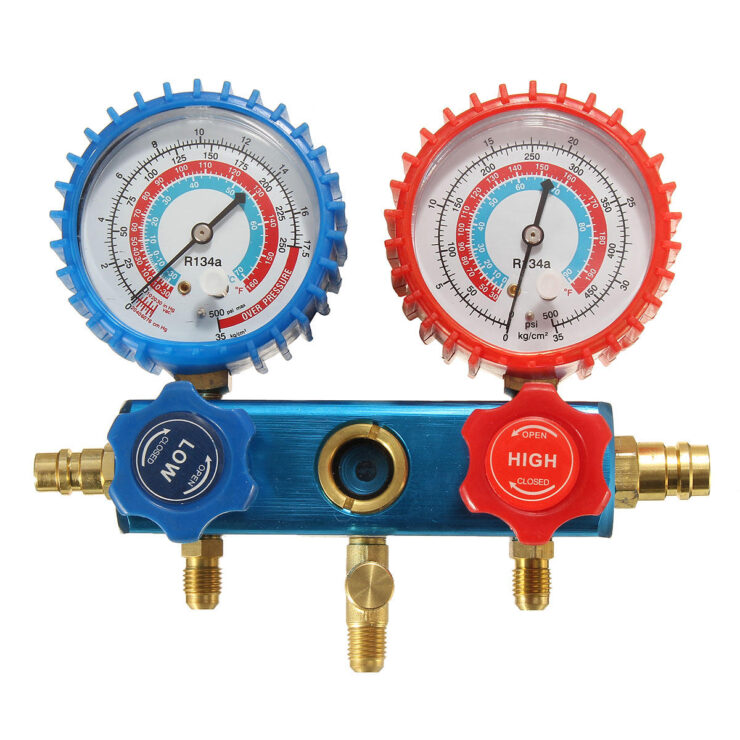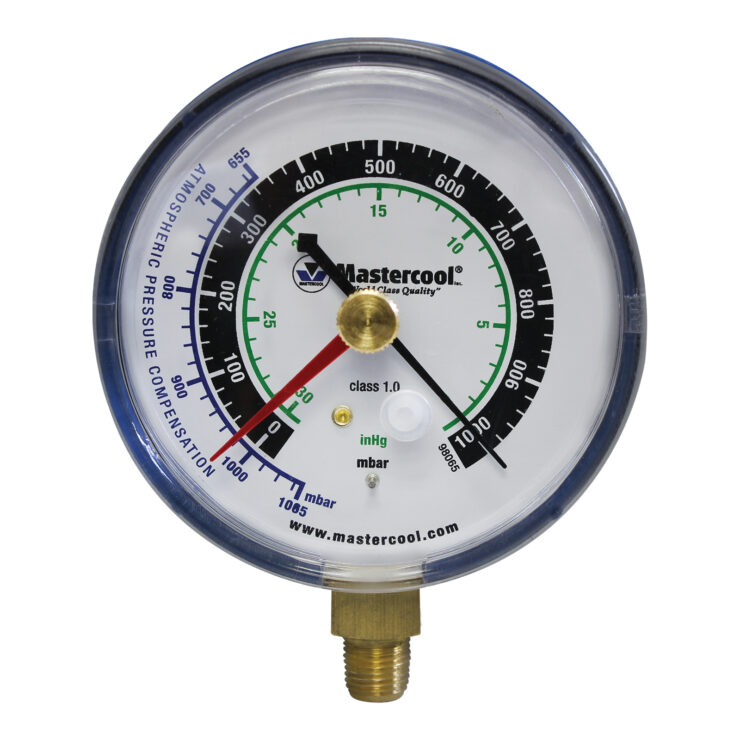If you don’t how to read AC gauges now, you’ll hate yourself later. This is the question is being asked by many and so here we present you a proper guide.
Also, compiled all the points, so you know about it thoroughly. AC gauges consist of two different valves connected to each other with a Details with a single spring pressure indication.
Sealing the gasket which is inside of the valve and is known for being environmentally strong and friendly.
What Is The AC Gauge?

An AC gauge is also known as the Manifold AC gauge set, is a device which helps in reading and controlling the pressure of the gases to be released for air conditioning.
It mimics the temperature and pressure of the air conditioning whenever it is operated. The rotating handle of this AC gauge is made of the strongest special material.
When the factory performs the torsion test in the laboratory of the professional institution, the number of torsions is up to 50,000 times. It is also capable of checking the humidity, temperature, and wind speedster if a digital analyzer is attached for HVAC systems.
Its manageability, simplicity of use, and reliability make it an especially versatile instrument suitable for all sectors of the air conditioning industry. There are mainly two types of AC gauges: analog and digital.
Performance is dependent on the accuracy obtained by knowing how to read AC gauges.
Let’s Learn How To Read AC Gauges Together!

Below, we will detail what it is, what it is used for, and how to read a refrigeration gauge. We will also see how they are used by knowing about the readings which are made by this device.
Let’s know about the color-coding first, it is important to know the color-coding that you can see on both the dials. There are mainly two colors: Blue and Red.
Blue: It stands for measuring the suction pressure of the compressor. Its scale mostly relies on the value from zero up to zero down by knowing the variation in atmospheric pressure.
Red: This color is more on identifying the time and increasing the pressure from the hose. It also has a good amount of utility so that we can know the high pressures that are rising from the air conditioning.
As it can be harmful, it needs to be kept in control.
Complete Procedure To Read AC Gauge:
Step 01: To read the AC gauge, look at it to read the manometer and so that you can locate yourself, when you read 10 they are pounds that is equal to psi, now when you ask for the bar they are 14.5 pounds or psi.
If split says in the specification on coolant it is 780g r22 bone 780g = 1.7 pounds.
Step02 : Then connect the manometer with the blue hose down and on the r22 meter, it marks almost 10 with the compressor starting.
And with the air turned off the needle almost reaches the top with the blue meter and in the red 125psi, now the psi is measured with the blue or red meter.
Step 03: The manometer available there, will have has 5 types of measurements, the smallest is r22, the next is r12, then r134a, and the other two do not know what they are.
Step 04: Do not mix what is the amount of refrigerant that the equipment contains, with the pressure of the same, those 780g of r22 is the total gas that the equipment contains, this amount may vary in pressure, depending on outside temperatures.
Step 05: Now that 125 psi that you take off, surely you have taken it with an outdoor temperature of 20 degrees approx., a day of 30 degrees you will have approximately 158 psi, well if in operation it gives you 10 pounds you should wait 15 to 20 minutes for the equipment to enter into regime working if you keep 10 pounds.
Step 06: Fill the fine pipe (in cold), you must add gas used in addition to up to 60 pounds. Each 14.5 psi is 1 bar. In practice you can round a bar to 15 pounds, it would be fine with 4 bars up to a certain extend.
Step 07: Now, you will see that the blue manometer has a smaller scale than the red one, normally the blue one is used for low pressure, or of suction.
The red one for high, compressor discharge, the other scales that you see you should notice that this is the centigrade sign or Fahrenheit that belongs to the temperatures corresponding to the gas that you measure.
If you have r22 and you measure 60 pounds you look at those scales it will mark you almost 1 degree Celsius, and in Fahrenheit 34.
Step 08: Then, readout the measures given by the refrigeration gauge, also called as freon pressure gauges, it shows the pressure in refrigeration, freezing and air conditioning systems in air conditioning, cold filling equipment, industrial refrigerators, as well as in cold rooms.
The refrigeration manometer has the same structure as a general manometer but with stricter specific characteristics, they use a special weld and are tested to avoid refrigerant leaks. And in this way, you can easily identify how to read AC gauges.
Types Of AC Gauges
Here, in both, the difference is more about how you find the reading. In many of the places, the digital AC gauge device has been implemented for quick reading of the pressure and gases.
But, this does not make the analogous AC gauges less efficient. You can still go with the analog devices as there are many experienced readers.
The tools for refrigeration have adapted to new technological advances, integrating digital functions such as automatic calculation of important data, such as, subcooling and superheating (superheat) which seek to be a useful tool.
However, sometimes there are myths that we must clarify to have a better vision of this tool and know the usefulness they offer us.
Now there are mainly two types of AC gauges:
Digital AC Gauges
A dial gauge (analog) is as simple to use as connecting the hoses and assuring. However, calculations are complicated, since additionally we must take the temperatures with a thermometer in the ducts of the system.
Use a table of refrigerants, make the operation and in this way, obtain the subcooling and the superheating (superheat) if it is necessary to charge the refrigerant or maintenance. It implies that this process will do it more times.
This is simplified in the digital device since that the pressure and temperature values treasured simultaneously. The refrigerant gas is selected and the equipment calculates directly and live the values of subcooling and overheating (superheat), in an easy way and effective.
Depending on the manufacturer and the ability to know about how to read AC gauges the device can be known for its efficiency. In this case, like the analog tools, some come with protectors for greater resistance.
When comparing we look for one that has a solid structure or by the sodium used (oils, coolants and more). It is made of a resistant material, some made of ABS, BA or TPE (TPE is one of the most resistant materials in the industry).
In refrigeration and HVAC systems, it is very necessary to know the value of the subcooling and the superheating (superheat) of the equipment. This parameter allows us to establish how the equipment works or what to check.
Analogous AC Gauges

In addition to the functions of digital equipment, the analogous equipment has incorporated intelligent functions in its internal structure. It clearly shows that it will not be a question anymore to ask about how to read AC gauges of analogous types.
Analogous AC gauge is thought and designed for hard work, which is a functional tool, used when a new refrigerant gas goes out. We should not buy it, and the Analogous AC gauges are upgradeable through the maintenance and care taken.
This device will work with full efficiency, which from the list of refrigerants (which is constantly updated) we select the gases we need an update. This allows the equipment to be functional, robust, and regularly updated, without the need to purchase new equipment.
In the case of Analogous AC gauge, damages do not occur easily since the user will give maintenance, valve change, purchase external sensors as spare parts or screen repair.
What Are HVAC Gauges?
The HVAC tube device is a device that is used in different sectors. This is because the HVAC tube device can measure various parameters, such as airspeed, atmospheric pressure, flow, and ambient temperature.
The device uses an HVAC tube, allowing air velocities up to 80 m / s to be measured. HVAC tube construction makes it easy to measure in tight spots, small holes, or small pipes. The digital interface also allows for real-time reading. Once you have established the connection you can see all the values in the software which are installed along with the reading.
As the HVAC tube device is a kit for use in different fields of application, special interest has been put in having a robust measuring instrument, which can be used in different environmental conditions.
For example, it has an ergonomic design and a backlit screen, allowing you to work with it in adverse lighting conditions. Mostly for reading the HVAC pressure, digital gauges are preferably used throughout the companies.
What Are The Digital HVAC Gauges?
- As the device uses an HVAC tube, allowing air velocities up to 80 m / s to be measured. HVAC tube construction makes it easy to measure in tight spots, small holes, or small pipes. The internal memory of the HVAC tube device allows 99 values to be registered per parameter.
- It is possible to retrieve such values on the computer screen or transfer them to a PC. The data transfer is done through the USB interface.
- Such technology has now taken place for getting quick results and maintaining the speed. With this, it becomes much easier to keep the record. The device can also lower the need of employees if it is brought from a renowned brand which provides you the 100% efficiency in the reading and calculation.
- You should always prefer to go with the latest trends and follow them with the utmost care. As any small malfunction will make all the efforts go in vain.
How To Read HVAC Gauges?
As we discussed earlier, on how to read AC gauges, the same is applicable for the Analogous model of the HVAC gauges. As they both function for the refrigeration and ventilation, all the parameters will be the same for taking the reading.
The manual reading is done by going through the blue and red color-coding marked on the dials. Blue ones are for the level zero up and down, giving the idea about the pressure in the atmosphere.
And the red ones are for denoting the time and knowing the increasing rate of the pressure. With this, you will be getting an accurate reading.
How To Use HVAC Manifold Gauges
The Digital Analyser
HVAC systems offer a wide range of features never before included in a single instrument. The digital device consists of two units for usage: a large LCD screen and a handheld sensor connected by a cable similar to that of a telephone.
The instructions on the LCD screen are clear to understand and easy to use.
Analogous Device
Measurement of the dynamic pressure “q” as the difference of the total pressure and the environmental static pressure “p”. This principle is used especially if the air to be measured has a very high flow rate and temperature.
Conclusion
In this manner, the AC and HVAC manifold gauge sets are used to test automotive air conditioning systems. With large and clear double indicators adopt the exclusive spring pressure indicator it gives more accurate for reading data.
Color-coded high, low pressure adjusted to the zero points, and digital devices are convenient for use. With a strong power, both digital and analogous are to make the best use of the gauges.
